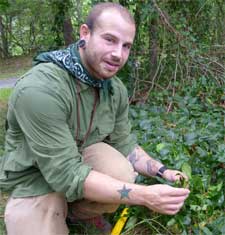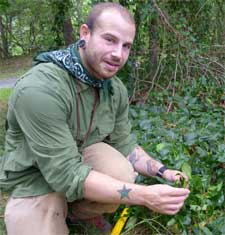 Summer research finds him bushwhacking in search of invasive plants
Summer research finds him bushwhacking in search of invasive plants
KINGSTON, R.I. – August 25, 2009 – University of Rhode Island sophomore Ryan Kleinert took an unusual route from high school to college, spending six years living alone in the wilderness of the southern Appalachian and Adirondack mountains before starting work on a wildlife conservation degree.
“I took that time to pursue my passions, immerse myself in the wilderness, surround myself with the things that I love – plants and animals – and learn directly from nature,” said the 24-year-old native of East Brunswick, N.J. “I spent my days exploring, canoeing, and studying herbalism and botany. But I realized I could only go so far with those studies, and I needed to pursue higher education to accomplish my goals.”
Kleinert, who now lives in Charlestown, R.I., said that despite having grown up in suburbia, he had what he called an “innate interest in wilderness, and at some point I rejected cement and wanted to live a more holistic lifestyle.”
The URI student carried that passion with him through his first year of classes, and he has spent the summer working with the Rhode Island Natural History Survey mapping invasive species in the state’s natural areas and working as the first line of defense against exotic invaders.
Kleinert spends his days bushwhacking through challenging landscapes with a handheld global positioning system to find, document and eradicate non-native plant species like multiflora rose, oriental bittersweet, Japanese honeysuckle, and privet.
“I’ve been to places that probably haven’t been visited by many people in a long time,” he said. “Just about every day I’m fighting my way through brier thickets, poison ivy, ticks and thick vines, going through culverts up to my waist in water and through a lot of bogs. It’s a lot of fun.”
His first project found him searching the area around Furnace Brook in Cranston for mile-a-minute vine, a fast-growing plant that can quickly take over a property and which was found in the state for the first time in 2008. He then worked with Lisa Tewksbury of the URI Biocontrol Lab to release a species of weevil that is the plant’s natural enemy in its Eurasian home region to try to slow its growth.
Kleinert followed that up with a survey of Chapman Pond in Westerly for sites to release beetles raised by Tewksbury to feed upon the invasive plant purple loosestrife. While working at the pond, he discovered only the third occurrence in the state of water chestnut, an Asian plant that can quickly clog ponds and waterways. He is now planning a major effort to remove the plants from the pond before they take hold and become impossible to eradicate.
“Next to habitat destruction, exotic invasive plants are the greatest threat to our native species,” said Kleinert, whose left arm is tattooed from wrist to shoulder with images of eight different birds and mammals. “If we can’t control these exotics, our native flora and fauna will be extirpated due to a loss of habitat and food sources. We’ll lose biodiversity, which will threaten our ecosystems. So we need to map out these exotic plants so we can strategically respond to them.”
Kleinert’s research is conducted through the URI Coastal Fellows program, a unique initiative designed to involve undergraduate students in addressing current environmental problems. Now in its 14th year, it is based at URI’s College of the Environment and Life Sciences. Students are paired with a mentor and research staff to help them gain skills relevant to their major and future occupations. Funding was provided by the Rhode Island Natural History Survey and the U.S. Fish and Wildlife Service.
During the next three years of his undergraduate education, Kleinert looks forward to continuing his work on invasive species, and eventually he hopes to pursue a graduate degree to study restoration ecology.
“Right now I want to get as much field experience as possible,” he said. “My goal is to preserve wild places, and invasives are a direct threat to the vitality of an ecosystem.”

